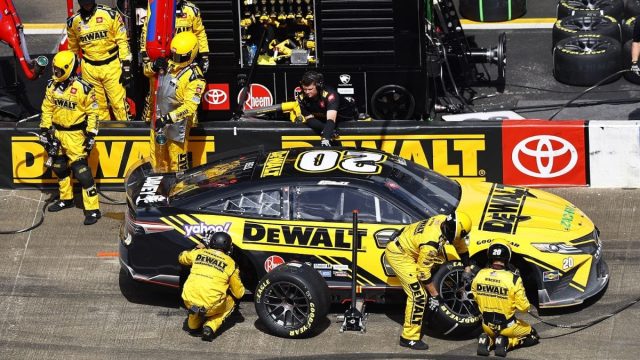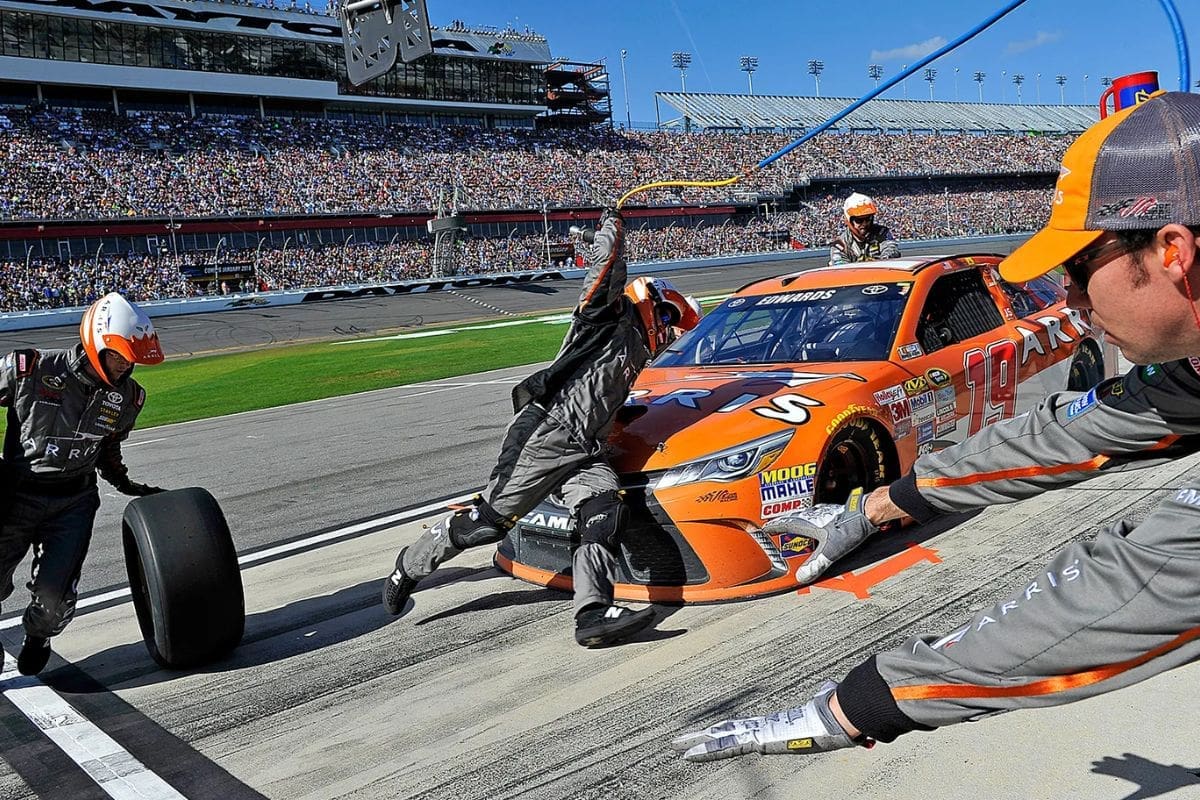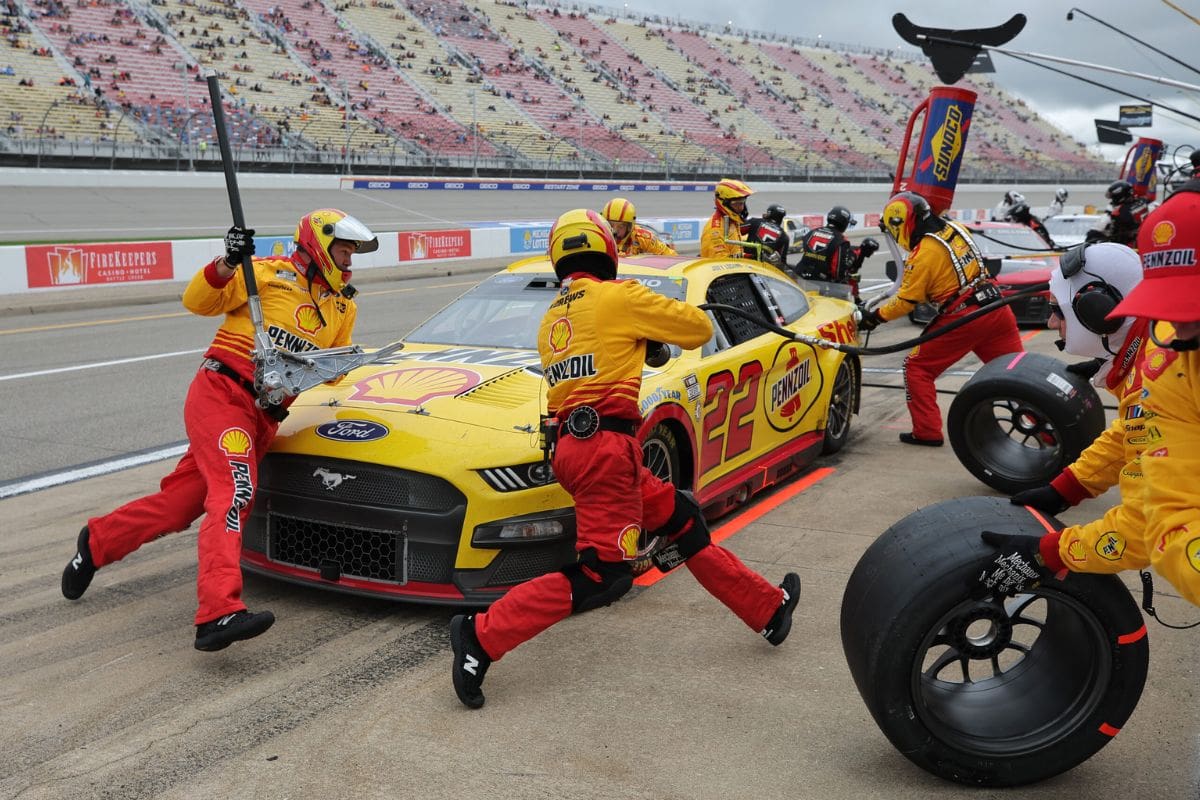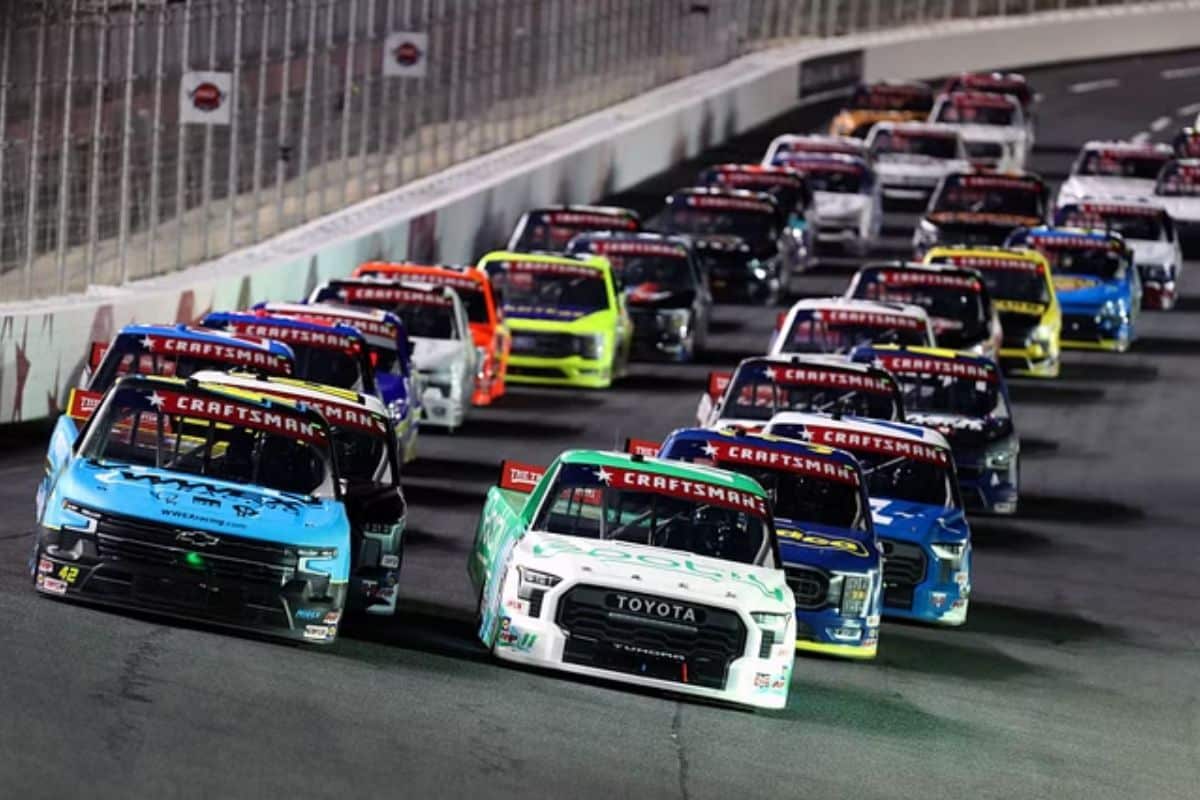Pit Stop Geniuses Joe Gibbs Racing: Joe Gibbs Racing‘s game-changing NASCAR pit stop strategy is a masterclass in speed, precision, and technological innovation. Their record-breaking 8.45-second pit stop at Texas Motor Speedway is a demonstration of rigorous training and teamwork. Employing advanced technologies such as biomechanical analysis, computer algorithms, and high-speed cameras, JGR sets new standards for efficiency and precision. The use of force plates and detailed data collection refines crew techniques to perfection. This strategy’s influence extends beyond NASCAR, shaping practices in Formula 1, team sports, and even military operations. To appreciate the full scope of their revolutionary methodology and its broader implications, delve further.
Key Highlights
- Joe Gibbs Racing achieved a record-breaking 8.45-second pit stop at Texas.
- Advanced technologies and data-driven methodologies revolutionized JGR’s pit stop strategy.
- Biomechanical analysis and high-speed cameras optimize crew performance and technique.
- Precision engineering with force plates and frame-by-frame footage ensures continuous improvement.
- JGR’s methodologies have applications in various fields beyond NASCAR.
Record-Breaking Pit Stop at Texas
In a landmark moment for NASCAR, the 2023 Texas race saw a team execute a record-breaking pit stop in a mere 8.45 ticks, highlighting the critical role of speed and precision in the sport’s intensely competitive environment. This extraordinary feat did not occur by chance; it was the result of meticulous planning, rigorous training, and the seamless operation of pit crew teamwork.
Achieving the fastest tire change in NASCAR history requires more than just speed; it demands the precision engineering of every component involved. The lug nuts, tire jacks, and even the choreography of the crew members must operate in flawless harmony. Each team member, akin to a speed demon, must perform their task with split-second accuracy, ensuring that no movement is wasted and every action contributes to the overall efficiency.
The strategy secrets behind such record-setting performances often lie in the cumulative hours of practice and the focus on incremental improvements. Teams dissect their routines, identifying areas where fractions of a tick can be shaved off. This incremental approach to performance improvement highlights the importance of both individual proficiency and collective synergy.
In NASCAR, where races can be won or lost in the pits, these elements of speed and precision are not merely advantageous but crucial. The 8.45-tick pit stop at Texas Motor Speedway serves as a confirmation to the heights that can be achieved when a team harmonizes their efforts and utilizes precision engineering. This achievement not only set a new benchmark but also exemplified the intricate and exhilarating nature of NASCAR pit stops, where every tick—and every detail—counts.
Joe Gibbs Racing’s Technological Revolution
Joe Gibbs Racing (JGR) has transformed NASCAR pit stops through the strategic implementation of advanced technologies and data-driven methodologies at the Joe Gibbs Human Performance Institute (JGHPI). This transformation is supported by the detailed use of biomechanical analysis, which carefully examines the movements and physical exertions of each pit crew member. By analyzing these biomechanical parameters, JGR identifies opportunities for performance optimization, minimizing time wastage and enhancing the smoothness of pit stop operations.
Central to JGR’s success is their adoption of cutting-edge technology and data analytics. The team utilizes sophisticated computer algorithms to process vast amounts of data collected during both practice sessions and live races. This data is then examined to produce actionable insights that guide the training regimens and tactical decisions of the pit crew. For example, real-time data analytics enable the team to dynamically adjust their strategies, ensuring peak performance even under the most unpredictable race conditions.
Incorporating creative strategies derived from these technological advancements, JGR has been able to develop training programs that simulate high-pressure race scenarios. These programs are tailored to enhance the efficiency and precision of each crew member. High-speed cameras and motion sensors are used to capture every detail of the pit stop process, enabling a deep understanding of areas needing improvement.
As a result, JGR’s pit crews execute their tasks with impressive speed and with a level of consistency and accuracy that sets them apart from their competitors. Through the integration of biomechanical analysis and data-driven performance optimization, JGR continues to redefine the standards of excellence in NASCAR pit stop strategy, solidifying their reputation as pioneers in the field.
Scientific Precision in Pit Stop Strategy
Precision engineering underpins every aspect of JGHPI’s pit stop strategy, leveraging advanced data collection tools such as force plates and high-speed cameras to fine-tune crew performance. This meticulous approach, characterized by data-driven precision, captures the subtleties of every crew member’s movement, providing detailed insights into their biomechanical actions.
The incorporation of over 80 force plates and more than 40 high-speed cameras ensures that no detail goes unnoticed, from the force applied during tire changes to the exact timing of each motion.
Biomechanical analysis, derived from this extensive data collection, plays a vital role in understanding and improving the efficiency of pit stops. By creating precise biomechanical models, JGHPI can identify inefficiencies and areas for improvement with scientific accuracy. These models simulate the physical demands and movements required during a pit stop, allowing the team to devise strategies that optimize crew performance. The insights gained from this analysis are instrumental in training programs, ensuring that each crew member can perform at their peak.
Performance optimization is at the heart of JGHPI’s strategy. The continuous feedback loop created by the integration of data collection and biomechanical analysis leads to iterative improvements. Every aspect of the pit stop process is scrutinized, from the ergonomics of tool usage to the synchronization of team actions, fostering a culture of continuous improvement.
Technological Arsenal Deployed by JGR
Leveraging a sophisticated array of state-of-the-art force plates and high-speed cameras, JGR’s technological arsenal provides unmatched insights into the biomechanics and movements of pit crew members. These advanced tools are crucial in understanding and refining the intricate actions performed during high-pressure pit stops, ensuring that every fraction of a moment is optimized for maximum efficiency.
The deployment of force plates allows JGR to carefully analyze the ground reaction forces exerted by pit crew members. This data is instrumental in optimizing their stance and movements, minimizing fatigue, and enhancing performance under the extreme conditions of a NASCAR race.
High-speed cameras, on the other hand, capture detailed, frame-by-frame footage of each crew member’s actions, offering a thorough view of their technique and identifying areas for improvement.
- Enhanced Biomechanics Insights: The combination of force plates and high-speed cameras provides a detailed understanding of each crew member’s biomechanical performance, leading to targeted training and refinement.
- Optimized Pit Crew Movements: Detailed analysis of movements allows for the fine-tuning of techniques, reducing the time taken for each pit stop and improving efficiency.
- Innovation Commitment: JGR’s investment in such cutting-edge technology highlights their firm commitment to innovation, setting a high standard within the competitive racing industry.
Impact Beyond NASCAR
The technological advancements spearheaded by JGR, particularly in the field of pit stop optimization, extend their utility beyond the boundaries of NASCAR, offering valuable applications in different sports and industries. The institute’s dedication to refining these strategies highlights an ongoing pursuit of excellence and a notable competitive advantage. By integrating science and technology into their racing operations, JGR sets a standard that transcends motorsports, influencing performance across different arenas.
In the domain of sports innovation, the methodologies developed by JGR can be adapted to other high-stakes environments where time efficiency and precision are crucial. For instance, in Formula 1, pit stop optimization can similarly shave critical seconds off a team’s race time, directly impacting their competitive edge. Furthermore, these principles can be applied to other team sports requiring rapid, coordinated actions, such as basketball or football, where quick substitutions and tactical adjustments can pivot the game’s outcome.
Beyond the sports domain, the industrial applications of JGR’s technological advancements are equally promising. Sectors such as manufacturing and logistics can benefit from the performance enhancement techniques honed by JGR. For example, assembly line workers can adopt pit stop-inspired efficiency methods to minimize downtime and streamline operations, thereby improving productivity and reducing costs.
Moreover, the competitive advantage gained through these advancements is evident in industries that rely on swift, synchronized actions, such as emergency medical services or military operations. The emphasis on precision and speed, core to JGR’s pit stop strategy, can significantly improve response times and operational effectiveness.
News in Brief: Pit Stop Geniuses Joe Gibbs Racing
The game-changing pit stop strategy employed by Joe Gibbs Racing, epitomized by their record-breaking performance in Texas Motor Speedway, signifies a profound shift in NASCAR.
By integrating technological advancements and scientific precision, JGR has set a new benchmark in motorsport efficiency.
The deployment of cutting-edge tools and methodologies has not only enhanced their competitive edge but also influenced broader applications beyond NASCAR.
This paradigm shift highlights the innovative potential of technology in high-stakes, performance-driven environments.
Our Reader’s Queries
Q. Does Joe Gibbs Racing still exist?
A. Joe Gibbs Racing (JGR) stands as a top-tier organization in NASCAR, fielding four teams in the NASCAR Cup Series, three teams in the NASCAR Xfinity Series, along with an ARCA Series team and a robust driver development program.
ALSO READ: NASCAR Full Speed: Netflix’s Pit Stop for Exclusive Racing Action



